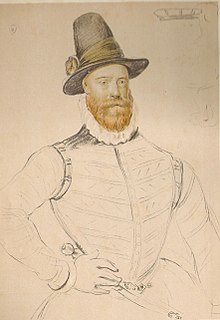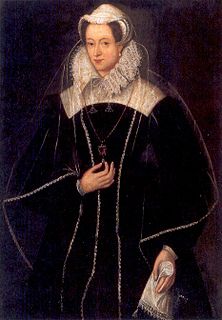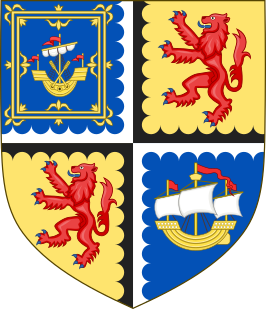| |||||
| Centuries: | |||||
|---|---|---|---|---|---|
| Decades: | |||||
| See also: | List of years in Scotland Timeline of Scottish history 1578 in: England • Elsewhere | ||||
Events from the year 1578 in the Kingdom of Scotland .
| |||||
| Centuries: | |||||
|---|---|---|---|---|---|
| Decades: | |||||
| See also: | List of years in Scotland Timeline of Scottish history 1578 in: England • Elsewhere | ||||
Events from the year 1578 in the Kingdom of Scotland .

James Hepburn, 1st Duke of Orkney and 4th Earl of Bothwell, better known simply as Lord Bothwell, was a prominent Scottish nobleman. He was known for his marriage to Mary, Queen of Scots, as her third and final husband. He was accused of the murder of Mary's second husband, Henry Stuart, Lord Darnley, a charge of which he was acquitted. His marriage to Mary was controversial and divided the country; when he fled the growing rebellion to Norway he was arrested and lived the rest of his life imprisoned in Denmark.

James Douglas,4th Earl of Morton was the last of the four regents of Scotland during the minority of King James VI. He was in some ways the most successful of the four, since he won the civil war that had been dragging on with the supporters of the exiled Mary, Queen of Scots. However, he came to an unfortunate end, executed by means of the Maiden, a predecessor of the guillotine.
Patrick Hepburn, 3rd Earl of Bothwell was the son of Adam Hepburn, Lord Hailes, who died at the Battle of Flodden the year after Patrick's birth.
Hepburn is a family name of the Anglo-Scottish border, that is associated with a variety of famous personages, eponyms, places, and things. Although commonly a Scottish name, its origins lie to the south of the border in the north of England. Specifically, the name is thought to have derived from Hepburn or Hebron in Northumberland or Hebburn in Tyne and Wear. The origins of the name are suggested to be the same as that of Hebborne from the Old English words heah ("high") and byrgen. Alternatively it could mean something along the lines of "high place beside the water", as the word burn is a still widely used in Northumbrian and Scots for stream.

Hermitage Castle is a semi-ruined castle in the border region of Scotland. It is under the care of Historic Scotland. The castle has a reputation, both from its history and its appearance, as one of the most sinister and atmospheric castles in Scotland.

Borthwick Castle is one of the largest and best-preserved surviving medieval Scottish fortifications. It is located twelve miles (19 km) south-east of Edinburgh, to the east of the village of Borthwick, on a site protected on three sides by a steep fall in the ground. It was constructed in 1430 for Sir William Borthwick, from whom the castle takes its name,

The Casket letters were eight letters and some sonnets said to have been written by Mary, Queen of Scots, to the Earl of Bothwell, between January and April 1567. They were produced as evidence against Queen Mary by the Scottish lords who opposed her rule. In particular, the text of the letters was taken to imply that Queen Mary colluded with Bothwell in the murder of her husband, Lord Darnley. Mary's contemporary supporters, including Adam Blackwood, dismissed them as complete forgeries or letters written by the Queen's servant Mary Beaton. The authenticity of the letters, now known only by copies, continues to be debated. Some historians argue that they were forgeries concocted in order to discredit Queen Mary and ensure that Queen Elizabeth I supported the kingship of the infant James VI of Scotland, rather than his mother. The historian John Hungerford Pollen, in 1901, by comparing two genuine letters drafted by Mary, presented a subtle argument that the various surviving copies and translations of the casket letters could not be used as evidence of their original authorship by Mary.
Bothwell is a town in Scotland.

Malmö Castle is a fortress located in Malmö, Scania, Sweden. It is owned by the Swedish state and is managed by the State Property Agency. Malmöhus is part of Malmö Museums.

Crichton Castle is a ruined castle near the village of Crichton in Midlothian, Scotland. It is situated at the head of the River Tyne, 2 miles (3.2 km) south of the village of Pathhead, and the same distance east of Gorebridge.
Archibald Douglas, Parson of Douglas, was also Parson of Glasgow, a Senator of the College of Justice, Ambassador to Queen Elizabeth I of England, and a notorious intriguer.
Gunpowder, Treason & Plot is a 2004 BBC miniseries based upon the lives of Mary, Queen of Scots and her son James VI of Scotland. The writer Jimmy McGovern tells the story behind the Gunpowder Plot in two parts, each centred on one of the monarchs.
James Hepburn may refer to:
Anna Tronds, known in English as Anna Throndsen and posthumously as Anna Rustung, was a Dano-Norwegian noblewoman. In English and Scots history, Anna Throndsen is best known for her marriage to James Hepburn, 4th Earl of Bothwell, a man who later married Mary, Queen of Scots. Anna Throndsen is also known for her possible but much debated and disputed involvement in drafting some of the famous Casket Letters; these letters being the principal evidence against Mary.
Elizabeth Gordon, Countess of Huntly, was a Scottish noblewoman and the wife of George Gordon, 4th Earl of Huntly, Scotland's leading Catholic magnate during the reign of Mary, Queen of Scots. In 1562, Elizabeth encouraged her husband to raise forces against Queen Mary which led to his being outlawed, and after his death, his titles forfeited to the Crown. Elizabeth's son Sir John Gordon was executed for having taken part in his father's rebellion.

Jean Gordon, Countess of Bothwell was a wealthy Scottish noblewoman and the second wife of James Hepburn, 4th Earl of Bothwell. He became, after his divorce from Lady Jean, the third husband of Mary, Queen of Scots. Lady Jean herself had a total of three husbands. Upon her second marriage, she became the Countess of Sutherland.
Janet Beaton, Lady of Branxholme and Buccleugh (1519–1569) was an aristocratic Scottish woman and a mistress of James Hepburn, Earl of Bothwell. She had a total of five husbands. One of her nieces was Mary Beaton, one of the four ladies-in-waiting of Mary, Queen of Scots, known in history as the four Marys. In her lifetime, she was accused of having been a witch. Janet was immortalised as Sir Walter Scott's Wizard Lady of Branxholm in his celebrated narrative poem "Lay of the Last Minstrel".

Jean Hepburn, Lady Darnley, Mistress of Caithness, Lady Morham was a Scottish noblewoman and a member of the Border clan of Hepburn. Her brother was James Hepburn, Earl of Bothwell, the third husband of Mary, Queen of Scots. Jean's first husband was John Stewart, 1st Lord Darnley, an illegitimate half-brother of Queen Mary, which made Jean a double sister-in-law of the queen. Jean married three times. She was also Lady of Morham, having received in 1573 the barony of Morham and lands which had belonged to her mother, Lady Agnes Sinclair and was forfeited to the Crown subsequent to her brother, the Earl of Bothwell's attainder for treason.
John Lyon, 8th Lord Glamis was a Scottish nobleman, judge and Lord High Chancellor of Scotland.

George Sinclair was a Scottish nobleman, the 4th Earl of Caithness and chief of the Clan Sinclair, a Scottish clan of the Scottish Highlands.